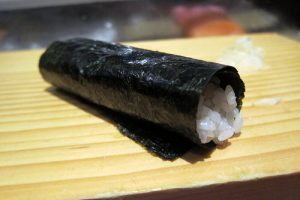
Japanese green teas often exhibit a fresh and marine aroma, very similar to seaweed.
It’s an indicative of good quality.
Some people mistakenly call it a “fishy” aroma. If that smell was actually present, it would be very undesirable.
I guess that the easiest way to get more familiar with it would be to smell a sheet of nori right after opening the package.
You have probably eaten nori before, since it is what sushi is wrapped in.
But where does this seaweed smell (and flavor) come from?
Dimethyl sulfide
Dimethyl sulfide (DMS) is a compound with chemical formula C2H6S. It’s generally described as having a smell of cooked cabbage, asparagus, sweet corn, and seaweed.
With other impurities and in high concentrations, DMS exhibits a highly disagreeable smell.
DMS is an important component in the seashore aroma. It’s mostly produced by bacteria eating dead phytoplankton.
Seaweed and phytoplankton both contain dimethylsulfoniopropionate (DMSP), which forms into DMS when broken down by bacteria or when oxidized in the atmosphere.
Thus, you can detect DMS in seaweed’s aroma and taste.
DMS in green tea
DMS and its precursor S-Methylmethionine (SMM) are found in Japanese green tea, but not so much in Chinese green tea. The fact that Japanese tea is normally steamed has a lot to do with it.
This seaweed aroma is more prominent in teas with a high concentration of amino acids including high grade sencha, kabusecha and gyokuro.
Actually, the Japanese have a name for this aroma: Ooika (覆い香, cover aroma), and it refers to the characteristic smell of shaded teas like kabusecha and gyokuro.
It’s described as being similar to the smell of aonori, which by the way is a different type of seaweed than nori.
Since this aroma is very desirable, an experiment in Shizuoka was made in order to determine how to increase DMS an SMM.
It turns out that the best way is to store the unprocessed tea leaves at a temperature of 5 °C (41 °F ) for 100 hours.
Incidentally, you might have felt that the wet tea leaves of gyokuro smell like cooked asparagus. That’s because asparagus also contains DMS.
Some Japananese teas have such a high concentration of this compound that the wet tea leaves don’t just smell like seaweed, but like sea water.
I find this aroma to be very pleasant and relaxing.
Of course, once you drink the tea it doesn’t taste salty at all. But you can still feel the oceanic notes in it.
Sources:
https://www.jstage.jst.go.jp/article/bbb1961/27/1/27_1_56/_pdf





June 14, 2018
I thought I was the only one that noticed that Green Tea Smell like Seaweed.
September 8, 2018
I’m not crazy after all lol, i love Japanese green tea
November 20, 2020
Glad I read this article! Great info, as always!
November 20, 2020
Thank you Noli. Glad that you liked it.
November 16, 2021
I dissected a dogfish and it smelled like green tea lol. I was like “Does anyone else notice this smells exactly like green tea?”